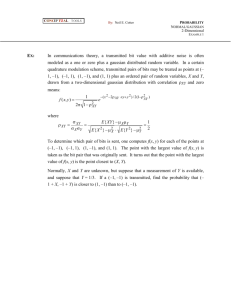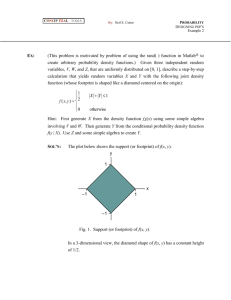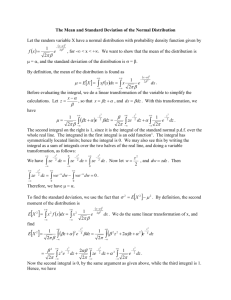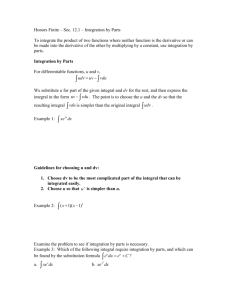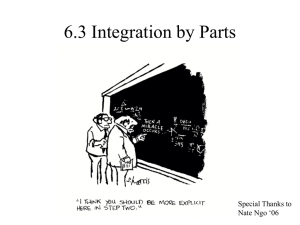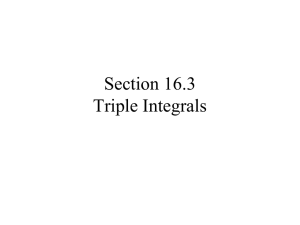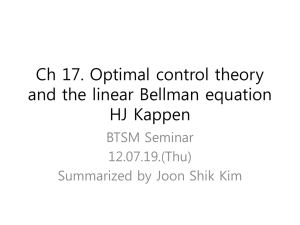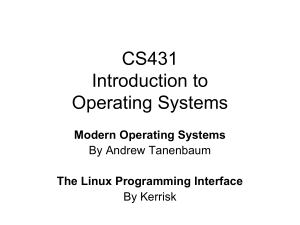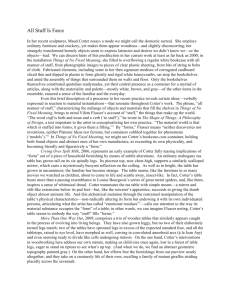Stats_tDistDerive
advertisement
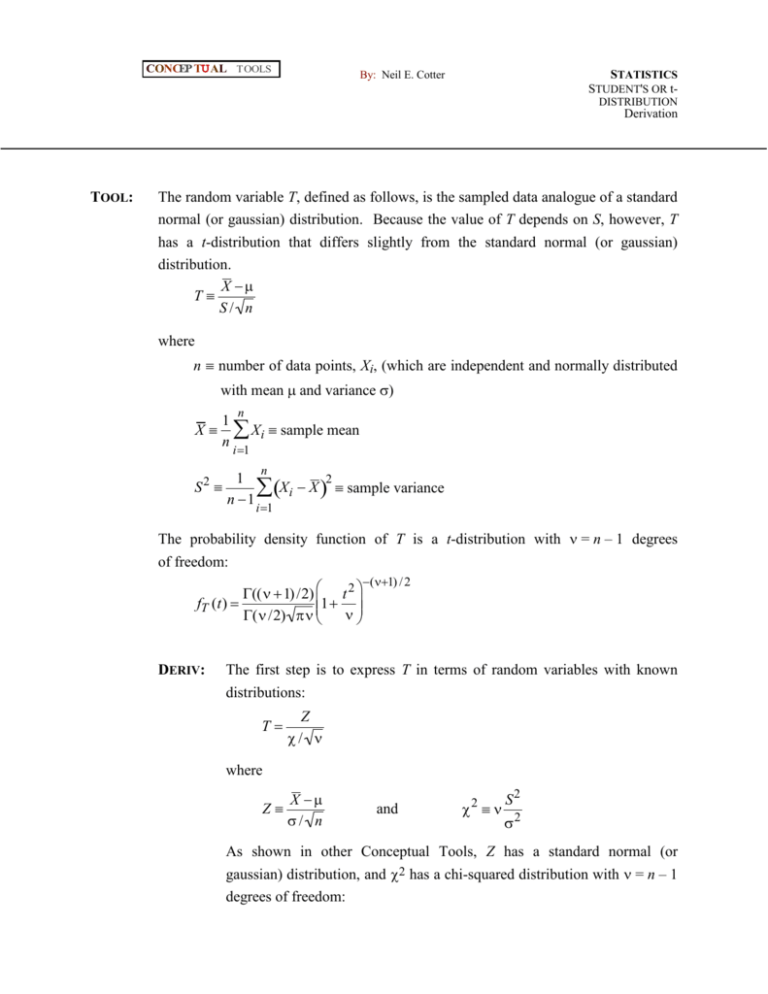
CONCEP TU AL TOOLS STATISTICS STUDENT'S OR t- By: Neil E. Cotter DISTRIBUTION Derivation TOOL: The random variable T, defined as follows, is the sampled data analogue of a standard normal (or gaussian) distribution. Because the value of T depends on S, however, T has a t-distribution that differs slightly from the standard normal (or gaussian) distribution. X T S/ n where n number of data points, Xi, (which are independent and normally distributed with mean and variance ) X n 1 Xi sample mean n i1 n 1 2 S X i X sample variance n 1 2 i1 The probability density function of T is a t-distribution with = n – 1 degrees of freedom: (1) / 2 (( 1) /2) t 2 1 fT (t) ( /2) DERIV: The first step is to express T in terms of random variables with known distributions: T Z / where Z X / n and S2 2 2 As shown in other Conceptual Tools, Z has a standard normal (or gaussian) distribution, and 2 has a chi-squared distribution with = n – 1 degrees of freedom: CONCEP TU AL TOOLS STATISTICS STUDENT'S OR t- By: Neil E. Cotter DISTRIBUTION Derivation (cont.) 1 z 2 / 2 e 2 f Z (z) 1 x ( / 2)1ex / 2 / 2 f 2 (x) 2 ( /2) 0 x 0 x 0 As shown in another tool, Z and 2 are also independent. This allows us to write the joint distribution of Z and 2 as the product of the respective probability density functions for Z and 2: 1 z 2 / 2 1 e x ( / 2)1ex / 2 / 2 2 ( /2) f (z, x) 2 0 x 0 x 0 To find the probability density for T, we consider the cumulative distribution for T and take its derivative: fT (t) NOTE: d d d FT (t) P(T t) z dt dt dt x / t f (z, x)dxdz We treat the case of t > 0. We have t in the lower limit in this case because larger values of x give smaller values of t. For the case of t < 0, we would integrate from –∞ to t. We move the derivative inside the outer integral and write the lower limit in terms of the x more clearly: fT (t) d dt x z 2 t2 f (z, x)dxdz The chain rule yields an interpretation of the derivative of the integral: d d dx f (z, x)dx f (z, x)dx 2 2 dt x z dx x z dt 2 2 t or t CONCEP TU AL TOOLS STATISTICS STUDENT'S OR t- By: Neil E. Cotter DISTRIBUTION Derivation (cont.) d 2z 2 2 f (z, x)dx f (z, x) x z dt x z 2 t3 t2 2 t Making this substitution, we have the following expression: 2z 2 2 fT (t) f (z, x) x z 3 dz 2 t t Now we use the expression for f(z, x), assuming t > 0: z 2 ( / 2)1 z 2 2 / 2 1 z 2 / 2 1 t e 2 f (z, x) x z 2 2 e /2 2 ( /2) t t2 0 NOTE: z0 z0 We have the condition that z > 0 because the definition of T requires Z > 0 to achieve T > 0. (X and X are always positive.) Incorporating the constraint on z into the lower limit of the outer integral yields the following expression: 2 z / 2 2 ( / 2)1 2 1 1 z 2z 2 t 2 z / 2 fT (t) e e 3 dz 0 2 2 / 2 ( /2) t 2 t It is helpful to define a term for the constants: k 2 1 1 1 1 ( / 2)1 / 2 / 2 (1) / 2 2 2 ( /2) 2 ( /2) Using this new term, we have the following expression: fT (t) k or z 2 ( / 2)1 2 2 / 2z 2 1 z 2 / 2z t e e 2 2 t dz 0 t t CONCEP TU AL TOOLS STATISTICS STUDENT'S OR t- By: Neil E. Cotter DISTRIBUTION Derivation (cont.) fT (t) k z 2 1 / 2 2 / 2 2 z 1 e t 2 t dz 0 t We define the following variable that allows us to use a convenient change of variables: zt z 1 2 t We have the following relationships for the change of variables: dz t dz , z 0 zt 0 , z zt 1 2 t and 2 1 zt2 1 2 1 21 1 2 1 t zt 2 zt zt 1 t 2 1 t 2 t t2 v 1 2 t v z2 In terms of zt we have the following integral expression: fT (t) k z t2 / 2 e 0 t 2 / 2 / 2 2 /2 zt 1 1 dzt 1 t2 or fT (t) k t 2 (1) / 2 2 z t / 2 2 / 2 1 e zt dzt 0 (1) / 2 We change variables again in order to make the integrand have the form of a chi-squared distribution: w zt2 We have the following relationships for the change of variables: CONCEP TU AL TOOLS STATISTICS STUDENT'S OR t- By: Neil E. Cotter DISTRIBUTION Derivation (cont.) dw dw dzt , zt 0 w 0, zt w 2zt 2 w In terms of w we have the following integral expression: (1) / 2 2 dw (1) / 2 t fT (t) k 0 w / 2ew / 2 2 w 1 By moving appropriate constants inside the integral, we obtain the integral of an entire chi-squared distribution with + 1 degrees of freedom. In other words the probability represented by the following integral must equal unity: 0 1 2 (1) / 2 (( 1) /2) w ((1) / 2)1ew / 2 dw 1 It follows that we have the following expression for the probability density function for T: fT (t) k2 (1) / 2 (( 1) /2) t 2 (1) / 2 1 (1) / 2 Simplification of the constants yields the final result: (1) / 2 (( 1) /2) t 2 1 fT (t) ( /2)
